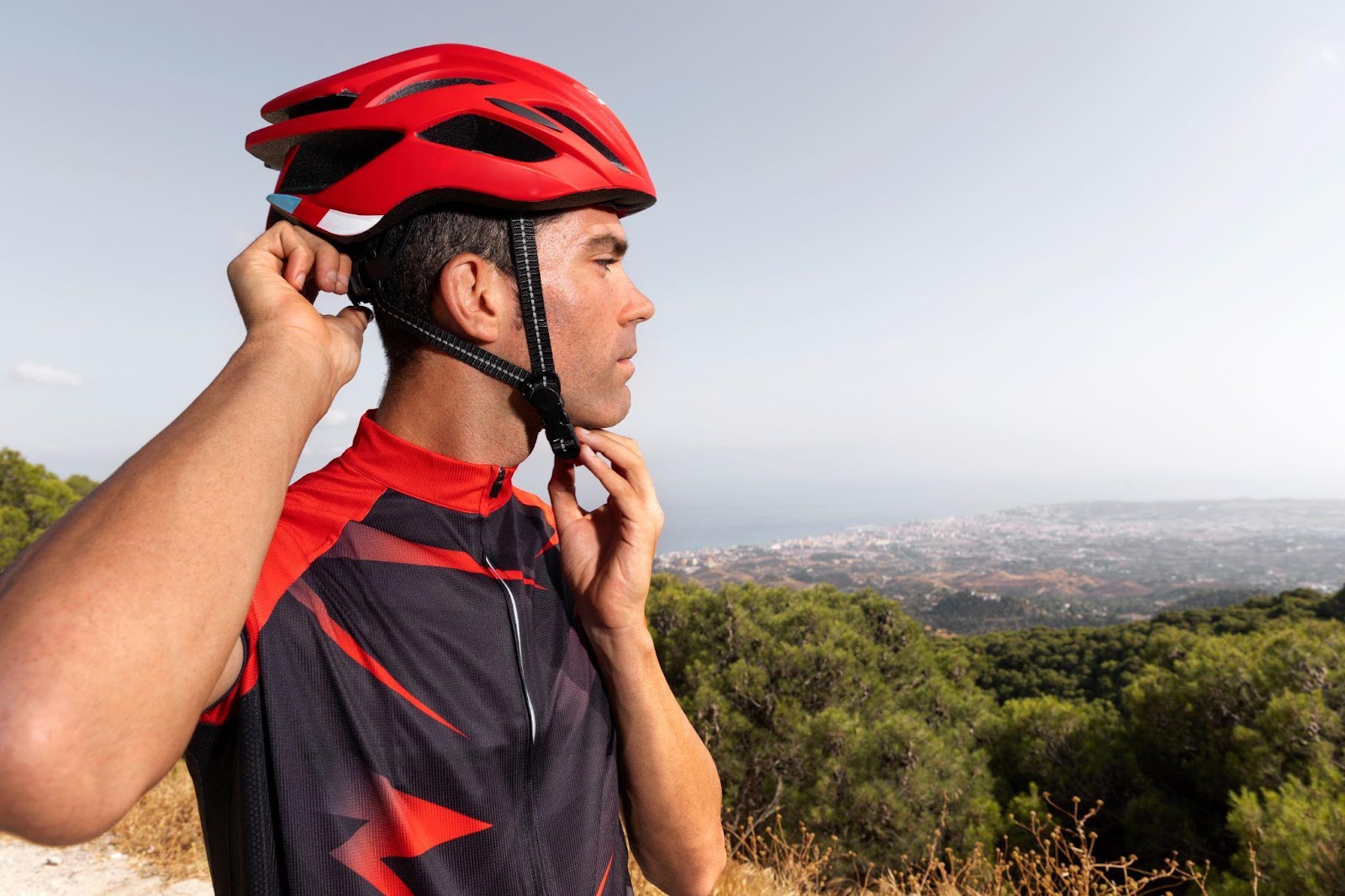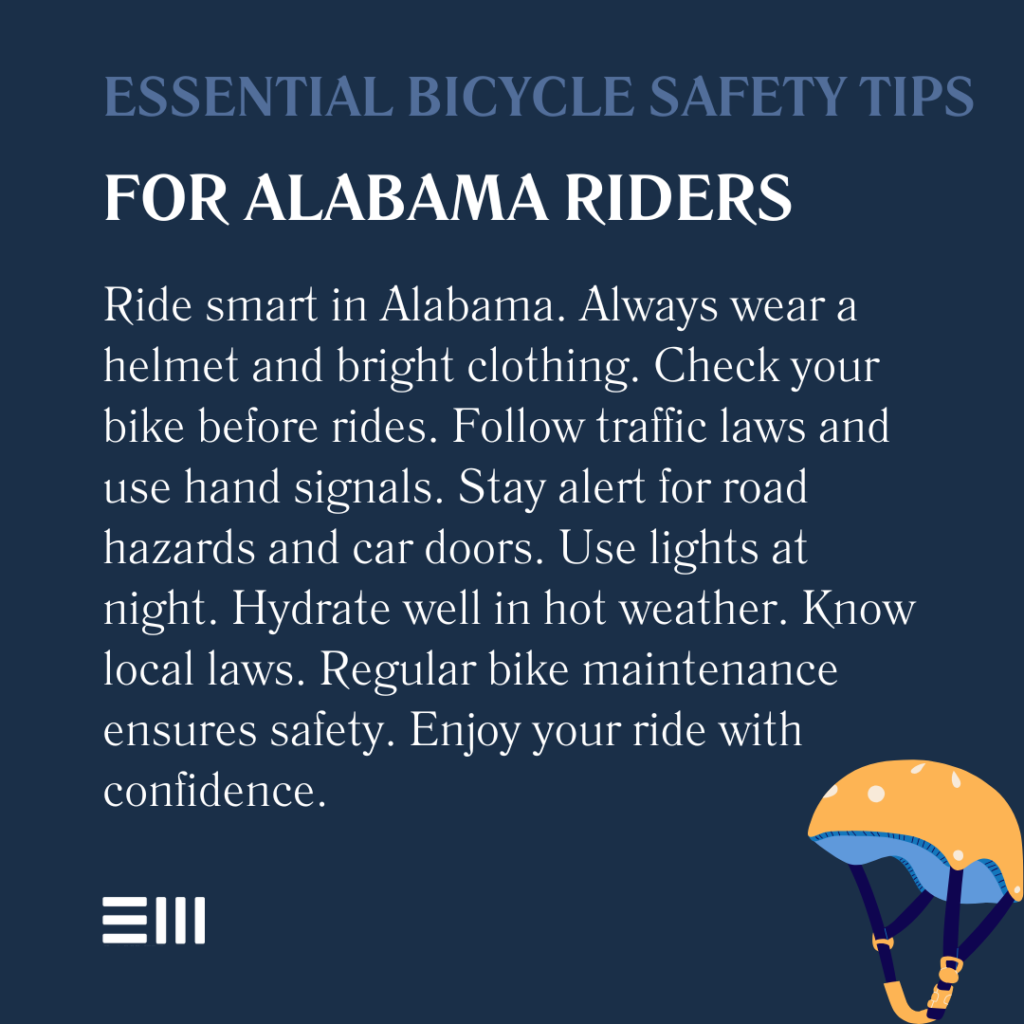
Ten-year-old Marcus skidded around the corner of his Birmingham neighborhood, racing his friends home from school. In a split second, his front wheel caught a crack in the sidewalk.
The impact sent him flying over his handlebars, his unprotected head aimed straight for the concrete. Thankfully, this isn’t Marcus’s story—because his mother insisted he wear a helmet that day.
The National Highway Traffic Safety Administration reports that helmet use reduces the risk of head injury by 60%, a statistic that represents countless children like Marcus who made it home safely because of this simple safety measure.
Understanding Alabama’s Bicycle Helmet Laws
Alabama’s approach to bicycle helmet legislation reflects a commitment to rider safety while respecting individual choice.
The state’s laws primarily focus on protecting young riders, recognizing their vulnerability, and the importance of instilling safe cycling habits early.
State-Level Regulations
At the state level, Alabama does not mandate helmet use for all cyclists. However, this absence of a universal law doesn’t diminish the importance of helmet use.
Instead, it places the responsibility on riders and parents to make informed decisions about their safety.
Local Ordinances: A Patchwork of Protection
While state law remains silent on universal helmet use, several Alabama municipalities have taken the initiative to enact their own bicycle helmet ordinances.
These local laws typically target younger riders, often requiring helmet use for cyclists under a certain age, commonly 16 years old.
For example:
- Anniston requires helmets for riders under 16; and
- Homewood mandates helmet use for cyclists under 16 on public property.
It’s crucial for cyclists to familiarize themselves with local ordinances in the areas where they ride, as these laws can vary significantly from one city to another.
Enforcement and Penalties
Enforcement of bicycle helmet laws in Alabama tends to be educational rather than punitive.
Law enforcement officers often use violations as opportunities to educate riders and parents about the importance of helmet use.
In some cases, first-time offenders may receive warnings rather than fines.
Where they exist, penalties for non-compliance are typically modest. They’re designed more to encourage compliance than to punish riders.
Some localities even offer programs where cited riders can have their fines waived by attending a bicycle safety course or obtaining a proper helmet.
The Importance of Bicycle Helmets: Beyond the Law
Cycling, while an enjoyable and healthy activity, comes with inherent risks. Head injuries are among the most severe consequences of bicycle accidents.
The human skull, while resilient, is not designed to withstand the forces involved in cycling collisions or falls.
A properly fitted bicycle helmet acts as a critical line of defense, absorbing impact and reducing the risk of traumatic brain injuries. It’s not just about avoiding scrapes and bruises; it’s about preserving cognitive function and, in many cases, saving lives.
Helmet Effectiveness: Numbers Don’t Lie
The statistics supporting helmet use are compelling:
- Helmets reduce the risk of head injury by up to 60%;
- They decrease the chance of brain injury by 58%; and
- Facial injuries are reduced by 47% with proper helmet use.
These numbers translate to real lives saved, and families spared the trauma of severe cycling accidents.
Choosing the Right Helmet: A Guide to Safety and Comfort
Selecting the appropriate helmet is as crucial as the decision to wear one. A poorly fitted or inadequate helmet may not provide the necessary protection in the event of an accident.
Types of Bicycle Helmets
- Road Bike Helmets: Lightweight and aerodynamic, designed for speed and ventilation
- Mountain Bike Helmets: More coverage, especially at the back of the head, often with a visor
- Commuter Helmets: Balance of protection and comfort for everyday riding
- BMX Helmets: Full coverage for trick riding and racing, with face protection options
Fit and Sizing
A proper fit is essential for maximum protection:
- Measure your head circumference to determine the correct size;
- The helmet should sit level on your head, covering the forehead;
- Straps should form a ‘V’ under each ear when buckled; and
- There should be no more than a finger-width gap between your eyebrows and the helmet.
Safety Standards
Look for helmets that meet recognized safety standards:
- CPSC (Consumer Product Safety Commission) certification is mandatory for all bicycle helmets sold in the United States; and
- Additional standards like ASTM or Snell provide extra assurance of quality and protection.
Comfort Features
Consider these features for a more enjoyable riding experience:
- Ventilation: Adequate airflow keeps you cool during rides;
- Weight: Lighter helmets reduce neck strain on longer rides;
- Adjustability: Look for easy-to-use fit systems; and
- Visibility: Bright colors and reflective elements enhance safety in low-light conditions.
Choosing the right helmet not only enhances safety but also ensures a comfortable and enjoyable riding experience, no matter your cycling style.

Essential Bicycle Safety Tips for Alabama Riders
Wearing a helmet is just one aspect of bicycle safety.
Here are comprehensive tips to ensure a safe and enjoyable riding experience in Alabama.
- Perform a quick bike check;
- Dress for visibility;
- Plan your route;
- Follow traffic laws;
- Stay alert;
- Ride predictably; and
- Use lights.
Prioritizing safety on every ride helps protect you and others, making Alabama’s roads safer for all cyclists.

Maintaining Your Bicycle and Helmet for Optimal Safety
Regular maintenance of both your bicycle and helmet is crucial for ensuring they provide maximum protection and performance.
Regular cleaning:
- Wipe down your bike after rides, especially after wet or muddy conditions; and
- Keep the chain clean and well-lubricated.
Brake check:
- Inspect brake pads regularly for wear; and
- Ensure cables are not frayed or stretched.
Tire care:
- Check tire pressure before each ride; and
- Inspect tires for wear or embedded objects.
Proper storage:
- Store your helmet in a cool, dry place away from direct sunlight; and
- Avoid hanging the helmet by its straps, which can stretch them out.
Replacement schedule:
- Replace your helmet every 3-5 years, or sooner if it’s been involved in a crash; and
- Check for signs of wear like cracks, frayed straps, or compressed foam.
Consistent maintenance of your bicycle and helmet is key to ensuring safety and extending the lifespan of your gear, keeping every ride secure and smooth.
Frequently Asked Questions About Bicycle Helmet Laws in Alabama
Navigating the world of bicycle safety and helmet laws can be complex. Here are answers to some commonly asked questions to help clarify key points and address common concerns.
What Are the Penalties for Not Wearing a Helmet in Alabama?
Penalties vary by municipality. In cities with helmet laws, fines are typically modest, ranging from $10 to $50.
Many localities focus on education rather than punishment, offering alternatives like safety classes or helmet vouchers.
Do Adults Need to Wear Helmets in Alabama?
While not mandated by state law, adult helmet use is strongly recommended. Some local ordinances may require helmets for riders of all ages on certain trails or in specific areas.
How Often Should I Replace My Bicycle Helmet?
Replace your helmet every 3-5 years or immediately after any impact, even if no visible damage is apparent. Helmet materials degrade over time, reducing their protective capacity.
Can I Use a Skateboard or Rollerblading Helmet for Cycling?
It’s best to use a helmet specifically designed for cycling. While other helmets offer some protection, bicycle helmets are optimized for the specific impacts and scenarios common in cycling accidents.
Are There Any Exemptions to Local Helmet Laws?
Some localities may have exemptions for medical or religious reasons. Always check with local authorities for specific exemptions in your area.
How Do I Know if My Child’s Helmet Fits Correctly?
A properly fitting helmet should sit level on the head, covering the forehead. It shouldn’t rock back and forth or side to side. The chin strap should be snug but comfortable, allowing you to fit no more than two fingers between the strap and chin.
What Should I Do if I’m in a Bicycle Accident?
Even if you feel fine, seek medical attention to rule out hidden injuries. Report the accident to the police, gather information from any involved parties, and document the scene if possible. Don’t admit fault or make any statements about the accident without legal counsel.
Are There Any Bicycle Safety Courses Available in Alabama?
Yes, many communities offer bicycle safety courses. Check with local bike shops, community centers, or police departments for available programs. Some organizations also offer online safety courses.
Your Safety, Our Priority
At Baxley Maniscalco, we’re committed to promoting bicycle safety and advocating for the rights of cyclists across Alabama.
Whether you’re dealing with the aftermath of a cycling accident or seeking advice on your rights as a cyclist, our experienced team is here to help.
Ready to Ride Safely?
Don’t let uncertainty about bicycle laws or safety practices hold you back from enjoying the freedom of cycling.
Contact Baxley Maniscalco today for a free consultation.
Our knowledgeable attorneys can provide clarity on local laws, offer personalized safety advice, and ensure you’re well-equipped to handle any legal challenges that may arise on the road.
Can't find what you're looking for? Search our site below.










